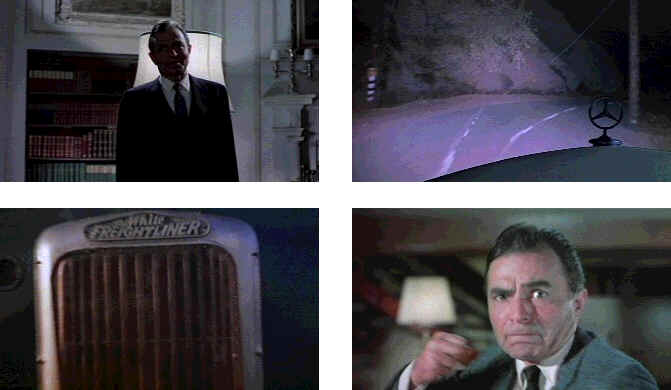Range Think about the fluctuation of the hierarchy of knowledge at these two moments in the narrative. How does the film manipulate the range of narration, and what is the effect of this manipulation? |
 |
 |
Narration: The plot’s distribution of story information to the viewer.
At any point in a given narrative, we can ask ourselves how much we know (as viewers) in relation to the characters on screen. This relationship can be represented as a hierarchy of knowledge and there are a few important terms we use to express these relationships.
First, we can analyze the range of narration:
Unrestricted narration: When the viewer knows more than any or all of the characters. Highly unrestricted narration is called omniscient.
Restricted narration: When the viewer knows only as much as a single character (usually the protagonist).
It’s important to note that the range of narration is a continuum, not a simple either/or category; it can fluctuate significantly over the course of a narrative. In general, however, mainstream Hollywood cinema tends to favor the unrestricted side of the scale.
We can also analyze the depth of narration:
Objective narration: Viewer’s knowledge is restricted to the external behavior of the characters. Highly objective narration (in certain forms of documentary, or in the films of Jim Jarmusch, for example) is known as "fly-on-the-wall."
Perceptual subjectivity: Viewer has access to the visual and aural perspective of the character through the "point-of-view shot."
Mental subjectivity:The viewer is plunged into the character’s mind and consciousness., with access to inner-thoughts (through voice-over narration), dreams, fantasies, visions, etc. Interestingly, however, even dream sequences are often narrated in an objective mode. For instance, in a dream, we see the character doing the dreaming, although if the sequence were truly perceptually subjective, we would probably have only pov shots. This demonstrates the power and prevalence of objective narration as a storytelling strategy.
Range Think about the fluctuation of the hierarchy of knowledge at these two moments in the narrative. How does the film manipulate the range of narration, and what is the effect of this manipulation? |
 |
 |
| Here’s another dramatic example of Hitchcock’s manipulation of narrative information. What is the effect of the sudden promotion of the viewer to the top of the hierarchy of knowledge? |
 |
Depth of Narration: The POV Shot
 |
Above are four pov shots from the film, three from Roger’s pov, and one from Leonard’s. Which one represents greater depth of narration? Below are two shots (one a pov shot) that, taken together, constitute an eyeline match. Note how the slightly low-angle long shot does a convincing job of approximating Roger’s relative position. |
 |